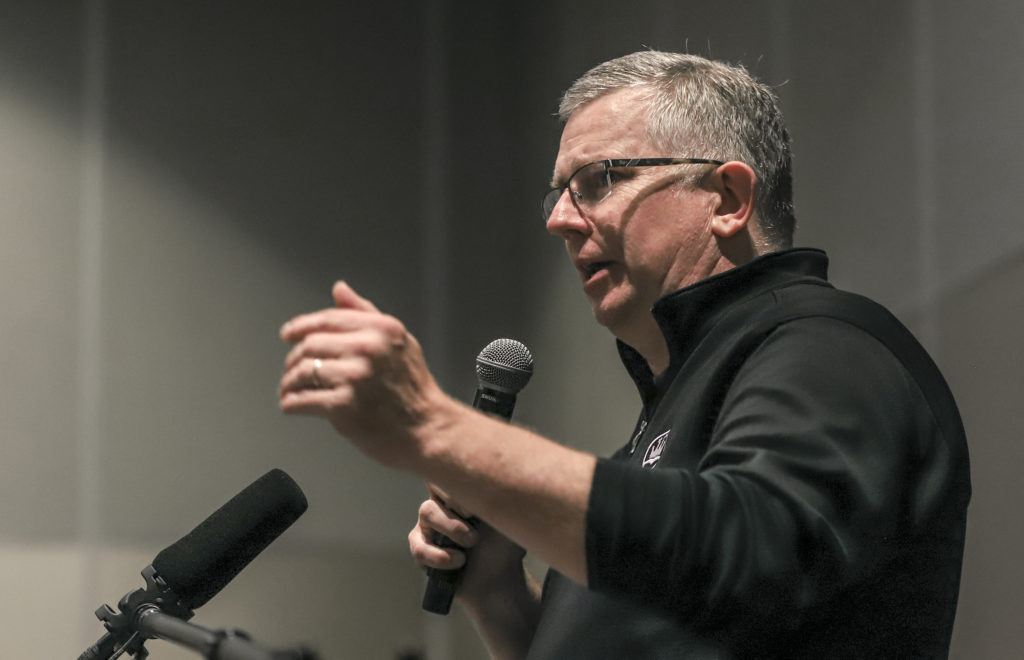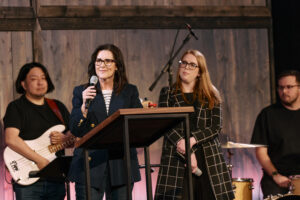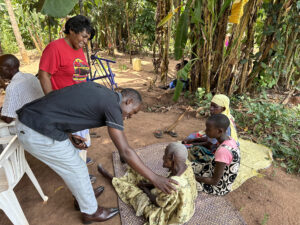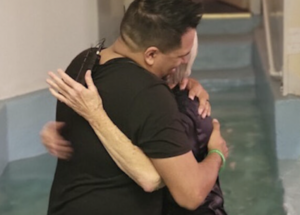
ANAHEIM (BP) – Three individuals closely tied to the recent Southern Baptist Convention Sexual Abuse Task Force report provided trauma-informed ministry training to nearly 60 people on June 14, immediately following the SBC’s afternoon business session.
The term “trauma informed” simply means accounting for the existence and impact of trauma in caring for others.
The presenters included attorney Rachel Denhollander, a recognized voice on the topic of sexual abuse, who served as special advisor to the SBC’s Sexual Abuse Task Force and a keynote speaker at the “Caring Well” conference sponsored by the SBC’s Ethics & Religious Liberty Commission; David Pittman, director of Together We Heal, a nonprofit that advocates for survivors of childhood sexual abuse, and one of the survivors identified in the Guidepost Solutions report; and Todd Benkert, pastor of Oak Creek Community Church in Mishawaka, Ind., who was instrumental in pushing a motion that led to the development of the task force.
The event was sponsored by SBC Voices, a blog that focuses on issues related to Southern Baptists from various “voices” who are invited to write; and New Growth Press, who provided printed materials on how to care for survivors of sexual abuse to attendees at the expense of two supporters — New Song Fellowship in Virginia Beach, Va., led by Brent Hobbs, lead pastor, and Cornerstone Baptist Church in Arlington, Texas, led by William Dwight McKissic, Sr., founder and senior pastor.
Todd Unzicker, executive director of the Baptist State Convention of North Carolina, opened the meeting with prayer, saying it was an honor to be with the survivors. He recounted how a few years ago, he promised he wouldn’t stop until all survivors are rescued.
“This is a special moment for a lot of us,” he stressed.
Benkert, acknowledging the survivors in the room and calling them great friends, shared the purpose of the gathering to talk about how trauma-informed care can be useful for the local church.
“We’ve been focusing on prevention and response,” he said, “but tonight is on how to minister hope and healing in a way that doesn’t reintroduce pain for survivors.”
Throughout the night, Denhollander discussed what trauma is and how it affects the person. Benkert shared about how Scripture addresses sexual abuse and sought to answer whether Scripture is sufficient. Pittman offered what trauma-informed care should look like in the local church.
What is trauma and how does it affect a person?
Denhollander, a former gymnast known for her work in the conviction of Larry Nassar, a serial sex offender and former U.S. gymnastics doctor, acknowledged many want to help sexual abuse victims, but often don’t know how.
“You have to understand what you are helping,” she stressed, pointing to how memories, positive and negative, work and are triggered.
Neuropathways develop whenever memories are formed, she explained, and the stronger or sharper the pathway, the stronger the memory is.
She used the illustration of the smell of pot roast to explain. Whenever she smells pot roast, she is transported back to the safety and happiness of being with her grandmother. The memories trigger a positive response in her body, bringing joy and peace, she said.
The same happens with traumatic memories, but they are stored and accessed differently in the brain, she said, explaining the brain of an abuse victim often looks like the brain of a stroke victim, where regions that shouldn’t light up are “blaring,” revealing “current” sensory input.
Survivors are not able to comprehend safety and may seem confused and irrational because they don’t remember the abuse like a movie, which happy memories bring; they reexperience the horrible memories – often to the point that it is hard to determine what is real.
A survivor herself, Denhollander recounted a time when a person walked near her at a store where she was shopping. His smell reminded her of the smell of her first abuser, causing her to black out.
“My neuropathway got triggered. … My fight and flee hormones were automatically released,” she said, describing the feeling to be like the jump of fear that is felt when her children play, “Let’s scare Mom.”
“When something startles you … your heart races, your stomach becomes upset, your skin tingles, and there is panic and danger.”
That fleeting feeling is where survivors often live chronically, she said. Most survivors live in a heightened state of fear and have lost the capability to self-regulate their bodies’ reactions. They live in a state of hyper-vigilance.
As a result, survivors often create coping mechanisms, such as wearing a belt or tennis shoes to bed or rearranging furniture to block entrances.
In church-based abuse, worship songs, certain scriptures, or the sound of a man’s voice reading Scripture can trigger these bodily responses, she said, noting there are a cascade of physical and emotional realities associated with abuse. One common example, she said, is that often survivors act out sexually to exercise control over what was taken from them. Many lose their ability to define what is wrong and are often in a cycle of abusive relationships.
This creates a paradigm shift in what is normal for survivors, Denhollander said, urging churches to recognize that anger and sin are really coping mechanisms for survivors, who are frequently mislabeled and misdiagnosed.
Most of the time when survivors disclose their abuse, their language will not be very clear, she said, adding that a person’s reality is shaped by what he or she experiences. Their perception of what is normal often isn’t normal.
Survivors begin to lack an understanding of what normal is. Those who attempt to assist survivors must begin by undoing what was experienced, and to start giving survivors language for what they have experienced. They describe what is normal and help the survivors frame it accurately.
Denhollander cautioned, “You are going to miss so many cries for help” if you don’t do this.
Acknowledging God created humans with bodies and souls, Denhollander said trauma doesn’t just cause “a thought wound but a physical wound.”
But we treat victims as though they just have thought wounds. She contrasted the difference between treating a patient with a spinal cord injury, where physical therapy is important.
Trauma injuries are physical injuries also, she said, urging ministers to look at root causes of pain. Healing the wounds begins with undoing the abuse, restoring agency, giving a voice and demonstrating compassion and justice.
Is Scripture sufficient?
Benkert spoke on how trauma-informed ministry relates to the Bible, stressing one must define the problems accurately to apply Scripture accurately.
Trauma is not answered with spiritual truisms, he said, pointing to two resources to help ministers, “The Body Keeps the Score” by Bessel van der Kolk, M.D; Suffering and the Heart of God by Diane Langberg.
“We must apply the whole counsel of God to the issue of trauma,” said Benkert. “The sufficiency is Scripture is limited by our unwillingness to follow the whole counsel of God. …
“Our very Savior is a man of sorrow and acquainted with grief.”
Benkert said church leaders must shift from only asking, “What is wrong with you?” (sin, which Jesus’ atoning sacrifice answers) to “What happened to you?” (suffering, of which Job’s friends didn’t have the vocabulary to address).
“We often focus on the theodicy of suffering (Romans 8:28) but we don’t have the answer to the very presence of suffering in someone’s life,” he said, lamenting this lack of focus.
Some pastors are afraid to preach because they don’t know how to deal with the trauma but the Bible, in Isaiah 61, points to how God seeks to give good news to the poor, captive and oppressed.
Benkert, who has friends who experienced sexual abuse and has cared for children in the foster care system who had been abused, is a missiologist and said he understands the importance of missionaries contextualizing their mission field.
With one out of four women and one out of six men affected by abuse, Benkert pointed to Diane Langberg’s assertion that “trauma is the mission field of our time.”
“We expect our missionaries to be well versed in the language, culture and problems of where they are serving,” he said. “What about this mission field?”
What does trauma informed care look like in the local church?
Pittman, a trainer for Godly Response to Abuse in the Christian Environment (GRACE), stressed the importance of “trauma” surgeons and “trauma” counselors.
Jesus fed, healed, and even brought the dead back to life three times, Pittman said, underscoring how survivors, who are often “hanging on a thread, are like those being brought back from the dead.”
And just as Jesus advocated for children in Matthew 19, others advocating for caring for the vulnerable is massively important, he said.
“Love the Lord … love your neighbor …. as you love yourself (Matthew 22),” he said.
He recounted the lack of empathy he encountered when he called church after church, entity after entity, to no avail, after his abuse. He likened it to the emergency room experience. How many times did you have to tell people the exact same thing? Did you wonder if anyone was listening?
“Imagine being sexually abused and having to say this over and over for years – decades,” he said.
“It’s not about having pity,” he said. “It’s saying, ‘I hear you. I believe you. How can I help? It was not your fault. Your feelings are natural.’”
Urging his listeners to research resources around them, including secular ones like 911 emergency dispatchers, he stated, “Don’t deny people the common grace of trauma-informed care.”
Pittman said churches must understand the stages of grief and one’s emotions. “There is no sin in righteous indignation,” he said.
They must also report to law enforcement. We are not qualified to investigate a crime, accuse and arrest a perpetrator or to question a victim, he said.
Develop response protocols. Real training using child advocacy experts is imperative, as is having a written policy enacted and enabled with the whole church body.
“If we think responding to sexual abuse is a distraction to the church, then we don’t understand the church and its mission,” he said.
Echoing Proverbs 31:9-10, which urges people to speak up for those who cannot speak for themselves, Pittman reminded that trauma care is not about rebuking and marginalization.
“We have to stop using benign language,” he said, sharing examples of language that is harmful to the process of healing, such as, “It wasn’t that bad,” “You need to get over it” and “It was adultery … inappropriate relationships.”
“No, it’s abuse and rape!” he said. “God did not will for children to be raped for His glorification. Saying those things causes more trauma.”
You are further harming the victim when you cause the victim to feel like the one in the wrong. It pushes them further from God.
Churches must be aware of how perpetrators groom victims and how they use their influence and language to garner sympathy.
He also shared what repentant perpetrators look like. They exhibit “a total admission of crimes, total submission to authorities, total acceptance of consequences, and voluntary acceptance of boundaries set up by the church.”
“Survivors were the truth-tellers, exposing the deeds of darkness. We cannot protect reputations,” he said, adding, “Child protection and risk management are not the same thing.”
He offered the following ways to help survivors:
- Build emotional, physical and spiritual safety.
- Have trustworthiness and transparency (“A narrative of a church that doesn’t include its worst moments will only set you up for more moments,” Pittman said. “Empower people to see the good, bad and ugly so they can determine to trust you.)
- Offer peer support.
- Work toward collaboration and mutuality (within church, community and other churches).
- Give survivors empowerment, choice and a voice.
- Have humility in the face of historical, cultural and gender factors (“We don’t know what another person’s experience is, he said. ‘In humility, count others more significant than yourself (Philippians 2:3).’”
In closing, Benkert pointed to survivor Debbie Vasquez, who persisted in telling her story, and Robert Downen of the Houston Chronicle, a reporter who has covered extensively the SBC’s sexual abuse story since 2019.
“If it weren’t for you, none of this that happened, would have happened,” Benkert said. “We can’t know these things and not do anything about them.”
To the attendees, he asked, “Will you go back and minister to people when you go back to your congregations?”
J.D. Greear, pastor of Summit Church in Durham, N.C., and former SBC president who initiated many of the Caring Well initiatives, closed the meeting in prayer but right before, he accepted an apology from Vasquez, who had included him in her accusations because she had not understood how Greear himself was prevented from doing more for survivors.
“Today is a small step but also a huge step,” Greear said. “If it had not been for your courage, we wouldn’t be where we are today.”
He quoted Winston Churchill, “Now this is not at the end. It’s not even the beginning of the end. But it is, perhaps, the end of the beginning.”
The session was recorded and will be posted alongside other resources on sbcvoices.com in the coming days.

















